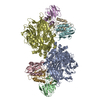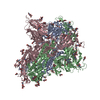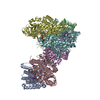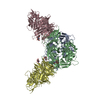+ Open data
Open data
- Basic information
Basic information
| Entry | Database: PDB / ID: 6x6a | ||||||
|---|---|---|---|---|---|---|---|
| Title | Cryo-EM structure of NLRP1-DPP9 complex | ||||||
 Components Components |
| ||||||
 Keywords Keywords |  IMMUNE SYSTEM / IMMUNE SYSTEM /  NLRP1 / NLRP1 /  DPP9 / DPP9 /  inflammasome / Val-boroPro (VbP) / talabostat / inflammasome / Val-boroPro (VbP) / talabostat /  innate immunity innate immunity | ||||||
| Function / homology |  Function and homology information Function and homology informationNLRP1 inflammasome complex assembly / cysteine-type endopeptidase activator activity / NLRP1 inflammasome complex / canonical inflammasome complex / The NLRP1 inflammasome /  dipeptidyl-peptidase IV / self proteolysis / dipeptidyl-peptidase activity / negative regulation of programmed cell death / dipeptidyl-peptidase IV / self proteolysis / dipeptidyl-peptidase activity / negative regulation of programmed cell death /  Hydrolases; Acting on peptide bonds (peptidases) ...NLRP1 inflammasome complex assembly / cysteine-type endopeptidase activator activity / NLRP1 inflammasome complex / canonical inflammasome complex / The NLRP1 inflammasome / Hydrolases; Acting on peptide bonds (peptidases) ...NLRP1 inflammasome complex assembly / cysteine-type endopeptidase activator activity / NLRP1 inflammasome complex / canonical inflammasome complex / The NLRP1 inflammasome /  dipeptidyl-peptidase IV / self proteolysis / dipeptidyl-peptidase activity / negative regulation of programmed cell death / dipeptidyl-peptidase IV / self proteolysis / dipeptidyl-peptidase activity / negative regulation of programmed cell death /  Hydrolases; Acting on peptide bonds (peptidases) / Hydrolases; Acting on peptide bonds (peptidases) /  pattern recognition receptor activity / pattern recognition receptor signaling pathway / cellular response to UV-B / stress-activated protein kinase signaling cascade / pattern recognition receptor activity / pattern recognition receptor signaling pathway / cellular response to UV-B / stress-activated protein kinase signaling cascade /  pyroptosis / cell leading edge / antiviral innate immune response / cysteine-type endopeptidase activator activity involved in apoptotic process / response to muramyl dipeptide / signaling adaptor activity / pyroptosis / cell leading edge / antiviral innate immune response / cysteine-type endopeptidase activator activity involved in apoptotic process / response to muramyl dipeptide / signaling adaptor activity /  aminopeptidase activity / molecular condensate scaffold activity / serine-type peptidase activity / positive regulation of interleukin-1 beta production / aminopeptidase activity / molecular condensate scaffold activity / serine-type peptidase activity / positive regulation of interleukin-1 beta production /  Hydrolases; Acting on acid anhydrides; Acting on acid anhydrides to facilitate cellular and subcellular movement / protein homooligomerization / positive regulation of inflammatory response / activation of cysteine-type endopeptidase activity involved in apoptotic process / : / Hydrolases; Acting on acid anhydrides; Acting on acid anhydrides to facilitate cellular and subcellular movement / protein homooligomerization / positive regulation of inflammatory response / activation of cysteine-type endopeptidase activity involved in apoptotic process / : /  double-stranded RNA binding / double-stranded RNA binding /  peptidase activity / peptidase activity /  regulation of inflammatory response / regulation of inflammatory response /  double-stranded DNA binding / defense response to virus / neuron apoptotic process / regulation of apoptotic process / double-stranded DNA binding / defense response to virus / neuron apoptotic process / regulation of apoptotic process /  microtubule / defense response to bacterium / protein domain specific binding / apoptotic process / microtubule / defense response to bacterium / protein domain specific binding / apoptotic process /  nucleolus / nucleolus /  enzyme binding / enzyme binding /  ATP hydrolysis activity / ATP hydrolysis activity /  proteolysis / proteolysis /  nucleoplasm / nucleoplasm /  ATP binding / identical protein binding / ATP binding / identical protein binding /  nucleus / nucleus /  cytosol / cytosol /  cytoplasm cytoplasmSimilarity search - Function | ||||||
| Biological species |   Homo sapiens (human) Homo sapiens (human) | ||||||
| Method |  ELECTRON MICROSCOPY / ELECTRON MICROSCOPY /  single particle reconstruction / single particle reconstruction /  cryo EM / Resolution: 3.6 Å cryo EM / Resolution: 3.6 Å | ||||||
 Authors Authors | Hollingsworth, L.R. / Sharif, H. / Griswold, A.R. / Fontana, P. / Mintseris, J. / Dagbay, K.B. / Paulo, J.A. / Gygi, S.P. / Bachovchin, D.A. / Wu, H. | ||||||
| Funding support |  United States, 1items United States, 1items
| ||||||
 Citation Citation |  Journal: Nature / Year: 2021 Journal: Nature / Year: 2021Title: DPP9 sequesters the C terminus of NLRP1 to repress inflammasome activation. Authors: L Robert Hollingsworth / Humayun Sharif / Andrew R Griswold / Pietro Fontana / Julian Mintseris / Kevin B Dagbay / Joao A Paulo / Steven P Gygi / Daniel A Bachovchin / Hao Wu /  Abstract: Nucleotide-binding domain and leucine-rich repeat pyrin-domain containing protein 1 (NLRP1) is an inflammasome sensor that mediates the activation of caspase-1 to induce cytokine maturation and ...Nucleotide-binding domain and leucine-rich repeat pyrin-domain containing protein 1 (NLRP1) is an inflammasome sensor that mediates the activation of caspase-1 to induce cytokine maturation and pyroptosis. Gain-of-function mutations of NLRP1 cause severe inflammatory diseases of the skin. NLRP1 contains a function-to-find domain that auto-proteolyses into noncovalently associated subdomains, and proteasomal degradation of the repressive N-terminal fragment of NLRP1 releases its inflammatory C-terminal fragment (NLRP1 CT). Cytosolic dipeptidyl peptidases 8 and 9 (hereafter, DPP8/DPP9) both interact with NLRP1, and small-molecule inhibitors of DPP8/DPP9 activate NLRP1 by mechanisms that are currently unclear. Here we report cryo-electron microscopy structures of the human NLRP1-DPP9 complex alone and with Val-boroPro (VbP), an inhibitor of DPP8/DPP9. The structures reveal a ternary complex that comprises DPP9, full-length NLRP1 and the NLRPT CT. The binding of the NLRP1 CT to DPP9 requires full-length NLRP1, which suggests that NLRP1 activation is regulated by the ratio of NLRP1 CT to full-length NLRP1. Activation of the inflammasome by ectopic expression of the NLRP1 CT is consistently rescued by co-expression of autoproteolysis-deficient full-length NLRP1. The N terminus of the NLRP1 CT inserts into the DPP9 active site, and VbP disrupts this interaction. Thus, VbP weakens the NLRP1-DPP9 interaction and accelerates degradation of the N-terminal fragment to induce inflammasome activation. Overall, these data demonstrate that DPP9 quenches low levels of NLRP1 CT and thus serves as a checkpoint for activation of the NLRP1 inflammasome. | ||||||
| History |
|
- Structure visualization
Structure visualization
| Movie |
 Movie viewer Movie viewer |
|---|---|
| Structure viewer | Molecule:  Molmil Molmil Jmol/JSmol Jmol/JSmol |
- Downloads & links
Downloads & links
- Download
Download
| PDBx/mmCIF format |  6x6a.cif.gz 6x6a.cif.gz | 494.5 KB | Display |  PDBx/mmCIF format PDBx/mmCIF format |
|---|---|---|---|---|
| PDB format |  pdb6x6a.ent.gz pdb6x6a.ent.gz | 374.6 KB | Display |  PDB format PDB format |
| PDBx/mmJSON format |  6x6a.json.gz 6x6a.json.gz | Tree view |  PDBx/mmJSON format PDBx/mmJSON format | |
| Others |  Other downloads Other downloads |
-Validation report
| Arichive directory |  https://data.pdbj.org/pub/pdb/validation_reports/x6/6x6a https://data.pdbj.org/pub/pdb/validation_reports/x6/6x6a ftp://data.pdbj.org/pub/pdb/validation_reports/x6/6x6a ftp://data.pdbj.org/pub/pdb/validation_reports/x6/6x6a | HTTPS FTP |
|---|
-Related structure data
| Related structure data |  22074MC  6x6cC M: map data used to model this data C: citing same article ( |
|---|---|
| Similar structure data | |
| EM raw data |  EMPIAR-10594 (Title: Human NLRP1-DPP9 complex / Data size: 2.3 TB EMPIAR-10594 (Title: Human NLRP1-DPP9 complex / Data size: 2.3 TBData #1: Unaligned multi frame micographs of NLRP1-DPP9-Apo-noTILT dataset [micrographs - multiframe] Data #2: Unaligned multi frame micographs of NLRP1-DPP9-Apo-TILT dataset [micrographs - multiframe]) |
- Links
Links
- Assembly
Assembly
| Deposited unit | 
|
|---|---|
| 1 |
|
- Components
Components
| #1: Protein |  / DP9 / Dipeptidyl peptidase IV-related protein 2 / DPRP-2 / Dipeptidyl peptidase IX / DPP IX / ...DP9 / Dipeptidyl peptidase IV-related protein 2 / DPRP-2 / Dipeptidyl peptidase IX / DPP IX / Dipeptidyl peptidase-like protein 9 / DPLP9 / DP9 / Dipeptidyl peptidase IV-related protein 2 / DPRP-2 / Dipeptidyl peptidase IX / DPP IX / ...DP9 / Dipeptidyl peptidase IV-related protein 2 / DPRP-2 / Dipeptidyl peptidase IX / DPP IX / Dipeptidyl peptidase-like protein 9 / DPLP9Mass: 98384.320 Da / Num. of mol.: 2 Source method: isolated from a genetically manipulated source Source: (gene. exp.)   Homo sapiens (human) / Gene: DPP9, DPRP2 / Cell line (production host): HEK293 / Production host: Homo sapiens (human) / Gene: DPP9, DPRP2 / Cell line (production host): HEK293 / Production host:   Homo sapiens (human) / References: UniProt: Q86TI2, Homo sapiens (human) / References: UniProt: Q86TI2,  dipeptidyl-peptidase IV dipeptidyl-peptidase IV#2: Protein | Mass: 136327.344 Da / Num. of mol.: 2 Source method: isolated from a genetically manipulated source Source: (gene. exp.)   Homo sapiens (human) / Gene: NLRP1, CARD7, DEFCAP, KIAA0926, NAC, NALP1 / Cell line (production host): HEK293 / Production host: Homo sapiens (human) / Gene: NLRP1, CARD7, DEFCAP, KIAA0926, NAC, NALP1 / Cell line (production host): HEK293 / Production host:   Homo sapiens (human) / References: UniProt: Q9C000 Homo sapiens (human) / References: UniProt: Q9C000#3: Protein | Mass: 29760.740 Da / Num. of mol.: 4 Source method: isolated from a genetically manipulated source Source: (gene. exp.)   Homo sapiens (human) / Gene: NLRP1, CARD7, DEFCAP, KIAA0926, NAC, NALP1 / Cell line (production host): HEK293 / Production host: Homo sapiens (human) / Gene: NLRP1, CARD7, DEFCAP, KIAA0926, NAC, NALP1 / Cell line (production host): HEK293 / Production host:   Homo sapiens (human) / References: UniProt: Q9C000 Homo sapiens (human) / References: UniProt: Q9C000 |
|---|
-Experimental details
-Experiment
| Experiment | Method:  ELECTRON MICROSCOPY ELECTRON MICROSCOPY |
|---|---|
| EM experiment | Aggregation state: PARTICLE / 3D reconstruction method:  single particle reconstruction single particle reconstruction |
- Sample preparation
Sample preparation
| Component | Name: DPP9-NLRP1 complex / Type: COMPLEX / Entity ID: #1 / Source: RECOMBINANT |
|---|---|
| Molecular weight | Units: KILODALTONS/NANOMETER / Experimental value: NO |
| Source (natural) | Organism:   Homo sapiens (human) Homo sapiens (human) |
| Source (recombinant) | Organism:   Homo sapiens (human) / Cell: HEK293 / Plasmid Homo sapiens (human) / Cell: HEK293 / Plasmid : pcDNA3.1 : pcDNA3.1 |
| Buffer solution | pH: 7.5 / Details: 25 mM Tris pH 7.5, 150 mM NaCl, 1 mM TCEP |
| Specimen | Conc.: 0.5 mg/ml / Embedding applied: NO / Shadowing applied: NO / Staining applied : NO / Vitrification applied : NO / Vitrification applied : YES : YES |
| Specimen support | Grid material: GOLD / Grid mesh size: 400 divisions/in. / Grid type: Quantifoil R1.2/1.3 |
Vitrification | Instrument: FEI VITROBOT MARK IV / Cryogen name: ETHANE / Humidity: 100 % / Chamber temperature: 278 K |
- Electron microscopy imaging
Electron microscopy imaging
| Experimental equipment |  Model: Titan Krios / Image courtesy: FEI Company | ||||||||||||||||||
|---|---|---|---|---|---|---|---|---|---|---|---|---|---|---|---|---|---|---|---|
| Microscopy | Model: FEI TITAN KRIOS | ||||||||||||||||||
| Electron gun | Electron source : OTHER / Accelerating voltage: 300 kV / Illumination mode: SPOT SCAN : OTHER / Accelerating voltage: 300 kV / Illumination mode: SPOT SCAN | ||||||||||||||||||
| Electron lens | Mode: OTHER / Calibrated magnification: 10500 X / Nominal defocus max: 2500 nm / Nominal defocus min: -1000 nm / Cs : 2.7 mm : 2.7 mm | ||||||||||||||||||
| Specimen holder | Specimen holder model: FEI TITAN KRIOS AUTOGRID HOLDER | ||||||||||||||||||
| Image recording | Imaging-ID: 1 / Film or detector model: GATAN K3 BIOQUANTUM (6k x 4k)
|
- Processing
Processing
| Software | Name: PHENIX / Version: 1.18.2_3874: / Classification: refinement | ||||||||||||||||||||||||||||
|---|---|---|---|---|---|---|---|---|---|---|---|---|---|---|---|---|---|---|---|---|---|---|---|---|---|---|---|---|---|
| EM software |
| ||||||||||||||||||||||||||||
CTF correction | Type: PHASE FLIPPING AND AMPLITUDE CORRECTION | ||||||||||||||||||||||||||||
| Particle selection | Num. of particles selected: 11197166 | ||||||||||||||||||||||||||||
| Symmetry | Point symmetry : C1 (asymmetric) : C1 (asymmetric) | ||||||||||||||||||||||||||||
3D reconstruction | Resolution: 3.6 Å / Resolution method: FSC 0.143 CUT-OFF / Num. of particles: 179306 / Algorithm: FOURIER SPACE / Num. of class averages: 1 / Symmetry type: POINT | ||||||||||||||||||||||||||||
| Refine LS restraints |
|
 Movie
Movie Controller
Controller












 PDBj
PDBj









